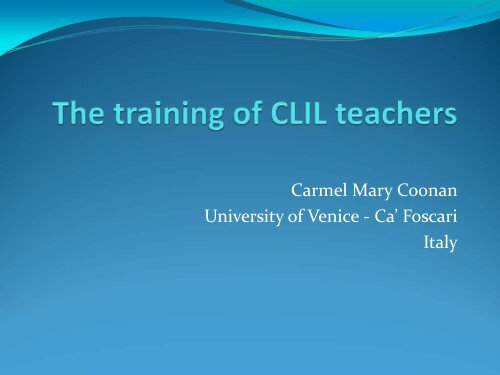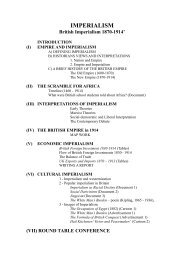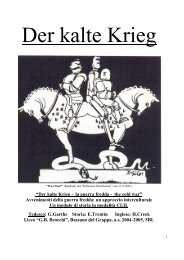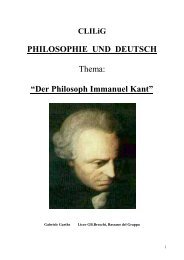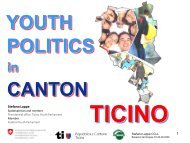read the PPT - CCLL: Common Constitution and Language Learning
read the PPT - CCLL: Common Constitution and Language Learning
read the PPT - CCLL: Common Constitution and Language Learning
You also want an ePaper? Increase the reach of your titles
YUMPU automatically turns print PDFs into web optimized ePapers that Google loves.
Carmel Mary Coonan<br />
University of Venice ‐ Ca’ Foscari<br />
Italy
Aim of talk<br />
Situation as it is<br />
What is needed<br />
Focus on CLIL teacher competences
Definition of CLIL<br />
Eurydice, 2006<br />
The acronym CLIL is used as a generic term to describe<br />
alltypesofprovisioninwhichasecondlanguage(a<br />
foreign, regional or minority language <strong>and</strong>/or ano<strong>the</strong>r<br />
official state language) is used to teach certain subjects<br />
in <strong>the</strong> curriculum o<strong>the</strong>r than <strong>the</strong> language lessons<br />
<strong>the</strong>mselves
Marsh, CLIL/EMILE –The European Dimension,<br />
2002<br />
“a pragmatic <strong>and</strong> pro‐active approach to foreign<br />
language learning” (p. 10)<br />
“CLIL <strong>and</strong> EMILE refer to any dual‐focused<br />
educational context in which an additional<br />
language, thus not usually <strong>the</strong> first language of <strong>the</strong><br />
learners involved, is used as a medium in <strong>the</strong><br />
teaching <strong>and</strong> learning of non‐language content”<br />
(p.15)
Eurydice, 2006<br />
In half of all countries specialist foreign language<br />
teachers are qualified to teach ano<strong>the</strong>r subject
Level of subject specialization among specialist teachers of foreign<br />
languages in primary <strong>and</strong>/or general lower secondary education,<br />
2002/03<br />
• Teacher qualified to teach two<br />
different subjects, one of which<br />
is a foreign language (light blue)<br />
• Teacher qualified to teach<br />
solely foreign languages<br />
(dark blue)<br />
• There are no detailed<br />
recommendations concerning<br />
specialist qualifications (stripes)<br />
• No specialist language teachers<br />
(grey)
CLIL TEACHERS IN ITALY<br />
CF. HANDOUT
Teacher training in CLIL<br />
HOW ARE INSTITUTIONS MEETING THESE<br />
TEACHERS’ TRAINING NEEDS?
QUESTIONNAIRE …<br />
… TO BEGIN TO FIND OUT WHAT PROVISION<br />
THERE IS<br />
(limited to <strong>the</strong> (areas of) countries <strong>and</strong> (several)<br />
institutions represented in <strong>the</strong> group)<br />
5 countries (Fr. Belg. Italy, Eng. Sp.)<br />
20 questionnaires
Picture<br />
Courses: most launched on or after <strong>the</strong> new millenium<br />
(exceptions)<br />
Providers: university (4); o<strong>the</strong>r educational institutions<br />
(majority), (networks of) schools<br />
Types of courses: postgraduate; complementary to a<br />
normal course; tailor‐made; professional develop. by<br />
schools
Cont.<br />
Great majority of courses are in‐service;<br />
All courses are optional;<br />
Recognition:<br />
No course provides qualifying status;<br />
University courses afford some kind of recognition<br />
for career (points, MA);<br />
Some courses are recognised as part of hours of<br />
obligatory professional develop.<br />
O<strong>the</strong>rs: none
Mode of delivery<br />
Mainly<br />
Face to face<br />
In situ<br />
Exception:<br />
On‐line (asinchronous)/blended (esp. tailormade)
Students<br />
Mainly:<br />
‐ qualified teachers disc. & FL (but cfr. università)<br />
‐ local provenance (excep. on‐line courses)<br />
Enrolment requirements:<br />
degree; exams; be part of a project; be<br />
a teacher; have interest; enrol as a couple; specific<br />
language competence level (very few ascertain this)
Evaluation <strong>and</strong> certif.<br />
University (mostly):<br />
summative of work assignments <strong>and</strong> final<br />
dissertation<br />
O<strong>the</strong>rs: none<br />
Certification:<br />
University: diploma (evaluation <strong>and</strong> attendance hours)<br />
O<strong>the</strong>rs: participation (hours) or no cert. at all
Connection with practice<br />
Great majority do not require a practicum (two<br />
universities only)<br />
Obligation to experiment in class during <strong>the</strong> course:<br />
universities yes; o<strong>the</strong>rs no
Tendencies<br />
Pre‐millenium Post millenium<br />
Length: courses get shorter (600h+ 12h)<br />
Quantity: provision increases<br />
Provider:<br />
pre‐millenium: University provides (<strong>and</strong> decides);<br />
post millenium: local education authorities;<br />
(network of) schools provide; schools ask <strong>and</strong><br />
sometimes decide alone
Tendencies<br />
Pre‐millenium Post millenium<br />
Mode of delivery:<br />
Greater contact with <strong>the</strong> schools; providers go out to <strong>the</strong><br />
schools = more situated<br />
Idea of a ‘course’ as ‘a priori’ structured content is<br />
integrated by idea of professional development being<br />
elaborated ‘in itinere’ <strong>and</strong> ‘in situ’ with <strong>the</strong> actors as<br />
<strong>the</strong>y act (‘reflection in <strong>and</strong> on action’)
Tendencies<br />
Pre‐millenium Post millenium<br />
Content:<br />
Pre‐millen. courses more <strong>the</strong>oretical<br />
Post‐milen. courses more practical;<br />
language courses also (very few)<br />
Attempt also to combine methodology <strong>and</strong> language<br />
element of courses with specific subject disciplines<br />
(very few)
Tendencies<br />
Pre‐millenium Post millenium<br />
Theoretical underpinnings:<br />
Variety of terms used to describe <strong>the</strong>m but all seem to<br />
indicate attempt to engage students in creating own<br />
knowledge <strong>and</strong> to develop competences:<br />
reflective; action research; task‐based learning;<br />
problem solving; collaborative; constructivist;<br />
professional dialogue; pragmatic.
Content<br />
Content is differently articulated. General areas (like<br />
below) are dealt with in many different ways:<br />
Fundamental CLIL Principles;<br />
Materials Design;<br />
Classroom Research<br />
Evaluation<br />
Web learning
A general consideration<br />
Need to provide for practice <strong>and</strong> application in <strong>the</strong><br />
actual classroom<br />
<br />
Students learn to create materials (work as plans) but<br />
are rarely seen using <strong>the</strong>m (work as process) so<br />
dynamics of classroom teaching in CLIL <strong>and</strong> all<br />
associated issues are not monitored
Needs analysis interviews:<br />
language area<br />
Teacher competence:<br />
‐ Need to improve language skills through work experience<br />
abroad<br />
‐ Need for specific language competence<br />
‐ Need to be linguistically flexible<br />
<strong>Language</strong> in CLIL lesson<br />
‐ Subj. Teachers need to underst<strong>and</strong> role of language in<br />
learning<br />
‐ Work out <strong>the</strong> role/balance between subj./L2 teacher in<br />
team teaching
Needs analysis:<br />
methodological area<br />
Know‐how:<br />
‐ to get learners to talk<br />
‐ create exercises, activities<br />
‐ strategies to overcome problems of comprehension<br />
Know that:<br />
‐ CLIL requires a change of mindset <strong>and</strong> of workpractices
Needs analysis: materials area<br />
Know how to:<br />
‐ Adapt <strong>and</strong> transform au<strong>the</strong>ntic documents for specific<br />
needs <strong>and</strong> goals<br />
Need:<br />
‐ to work with language teachers<br />
‐ for opportunities for joint work of teachers to develop/talk<br />
about materials, websites, exploitation<br />
‐ Specific CLIL websites, comparative periodical in different<br />
subjects; periodical newsletter on different <strong>the</strong>mes …
Needs analysis:<br />
methodological area<br />
Know‐how:<br />
‐ to get learners to talk<br />
‐ create exercises, activities<br />
‐ strategies to overcome problems of comprehension<br />
Know that:<br />
‐ CLIL requires a change of mindset <strong>and</strong> of workpractices
Needs analysis: materials area<br />
Know how to:<br />
‐ Adapt <strong>and</strong> transform au<strong>the</strong>ntic documents for specific<br />
needs <strong>and</strong> goals<br />
Need:<br />
‐ to work with language teachers<br />
‐ for opportunities for joint work of teachers to develop/talk<br />
about materials, websites, exploitation<br />
‐ Specific CLIL websites, comparative periodical in different<br />
subjects; periodical newsletter on different <strong>the</strong>mes …
Needs analysis: assessment area<br />
Oral language assessment<br />
Langage/subject: how to better balance
Semlang Summer University<br />
Views of participants concerning CLIL teacher training
Teacher qualifications<br />
Lack of training<br />
<strong>Language</strong> capacities of teachers: what level of competence by subject<br />
matter teacher?)<br />
<strong>Language</strong> teacher: how much content should <strong>the</strong> language teacher<br />
know? Should st<strong>and</strong>ards be set for <strong>the</strong>se competences? Could<br />
st<strong>and</strong>ards ‘kill’ CLIL<br />
Need for greater number of targeted courses<br />
Lack of schools where in service training in CLIL can be carried out –<br />
so where to find mentors (who trains <strong>the</strong>m?).<br />
Few schools so <strong>the</strong>re is no strong call on authorities to set up training<br />
Be part of pre‐service <strong>and</strong>/or in‐service training?<br />
Trainers: who trains <strong>the</strong>m?<br />
Single qualification of teachers in many countries
Dissemination of knowledge of CLIL<br />
Set up information <strong>and</strong> communication strategies<br />
to target students, fellow teachers <strong>and</strong> families<br />
Set up system of interlinked pre‐<strong>and</strong> in‐service<br />
training including provision of materials <strong>and</strong> o<strong>the</strong>r<br />
help) ‐ especially helpful for those countries<br />
where <strong>the</strong>re is nothing (Lithuania for example,<br />
Georgia, …<br />
Create data base of texts, materials <strong>and</strong> teaching<br />
principles
Costs aspect<br />
Few resources available from ministries –too much<br />
reliance on European money only
Pedagogical aspects<br />
Lack of teaching materials<br />
Competition between CLIL <strong>and</strong> o<strong>the</strong>r pedagogical<br />
str<strong>and</strong>s/departments competing for teaching hours –is<br />
detrimental to CLIL<br />
Issue of assessment<br />
Issue of assuring progression both in content <strong>and</strong> language<br />
‘Clash’ between a double methodology <strong>and</strong> lack of cooperation<br />
with subject teachers –very often caused by time constraints<br />
Problems related to difference in quantity: small phased –in<br />
approach versus bilingual immersion programmes<br />
Little focus on languages o<strong>the</strong>r than English
CLIL cosmos<br />
A galaxy of teacher competences
CLIL teacher competences<br />
CCN SURVEY –WORKING DOCUMENT<br />
OCTOBER ON THE CCN SITE FOR DISCUSSION<br />
http://www.ccn‐clil.eu
Objectives<br />
H<strong>and</strong>out of examples


